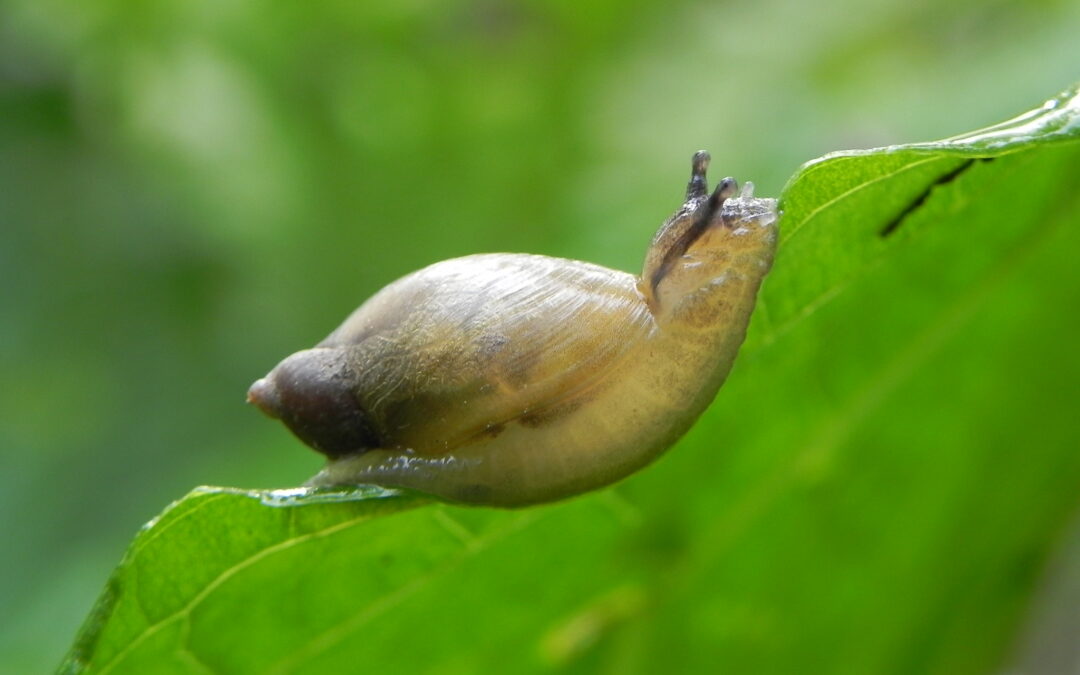By Emma Roth
Here at Audubon, we recently wrapped up our Discovery Walk season, when elementary school students visit us for guided walks along our trails. During these walks, we let the students decide what they will learn about based on their discoveries and curiosities. We respond to what they notice and see, and help them learn through experience.
This can make walks very unpredictable, as no two groups will notice and discover the same things. I found there was one creature that all students discovered and always sparked curiosity. This creature is the mighty snail.
Snails can be found all over Audubon. They are commonly found by students on the large leaves of the skunk cabbage plants that are found near our ponds and along the sides of the trails. These leaves are often covered in small holes where the snails have been slowly eating the plant.

The students’ curiosity inspired my own, especially after I ran into a particularly beautiful snail on a recent hike in Allegheny National Forest. I decided it was time to give these creatures the attention they deserve.
Snails are mollusks. This includes animals like slugs, clams, mussels, oysters, octopi, and squid. Mollusks vary hugely in looks, behavior, and ecological roles. All have soft, squishy bodies and a similarly structured nervous system, but that’s about all they have in common. Some mollusks have hard shells covering them. Some are soft and squishy all over, like slugs and octopi. Mollusks like oysters and clams are filter feeders, catching food that is carried in the currents of the water they live in. Others, like squid, actively search for food.
As mentioned before, snails here at Audubon are often found eating skunk cabbage and other leafy plants. They are also important decomposers, helping to break down decaying organic material. Snails are an important source of food for many animals, such as birds, mice, and turtles.
While snails are often found on land, Audubon’s ponds are also home to a few species of aquatic snails. It is almost impossible to dip a net into the vegetation of any of Audubon’s ponds and not come up with a snail, or at least an empty snail shell.
In many parts of the world, including North America, snails are relatively harmless, although they can carry parasites that can be harmful to people. There are places, however, where snails can be deadly. If you ever find yourself in a warm, tropical ocean, be on the lookout for cone snails.
Cone snails are beautiful creatures, but keep your distance. These snails are predators and have modified mouthparts that act like a harpoon to catch their prey and inject it with venom. When threatened, the snail can use this harpoon and venom as a form of defense. The effects of the venom on people varies based on the species of cone snail. Stings from the smaller species of cone snails feels similar to a bee sting; it is painful, but won’t kill you. Stings from the larger cone snails, however, can be fatal.
Along with being ecologically important in many ways, snails have been important to human culture for a long time. In Buddhism, it is said that 108 snails sacrificed themselves and covered Buddha’s head, aiding him in finding enlightenment. As such, snails are honored and thought of as martyrs.

Another example of snails in history comes from the 13th and 14th centuries. During this time, blank areas of books and documents were often filled with elaborate drawings and illustrations. These illustrations were sometimes based on what was written in the manuscript, but other times they were more abstract.
Many of these illuminated manuscripts have a strange and seemingly random image: an armored knight, often riding a battle horse, fighting a snail. Historians have not been able to figure out what this was supposed to represent. There are multiple theories. The snail could symbolize sin or various political enemies. Another theory is that it is purely for humor, a running joke placed by the artists purely for entertainment.
Snails have also been important subjects of art. One of the best examples is the work of Salvador Dali, who was somewhat obsessed with snails. His obsession began when he noticed a snail sitting on a bicycle outside of Sigmund Freud’s house. He was intrigued by the smooth lines and round shape of the snail, and the contrast of the soft body and hard shell. After that, he included snails in various paintings and sculptures.
In recent years, I have mostly overlooked snails. They are slow and often fairly drab in color. I am thankful to my discovery walk students for reminding me how neat snails really are, and for sharing their curiosity and enthusiasm for these creatures.
Audubon Community Nature Center builds and nurtures connections between people and nature. ACNC is located just east of Route 62 between Warren and Jamestown. The trails are open from dawn to dusk as is Liberty, the Bald Eagle. The Nature Center is open from 10 a.m. until 4:30 p.m. daily except Sunday when it opens at 1 p.m. More information can be found online at auduboncnc.org or by calling (716) 569-2345.


Recent Comments